Biology:Mastodon
| Mastodon | |
|---|---|
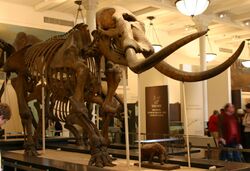
| |
| Mounted M. americanum skeleton (the "Warren mastodon"), AMNH | |
| Scientific classification | |
| Script error: No such module "Taxobox ranks".: | Animalia |
| Script error: No such module "Taxobox ranks".: | Chordata |
| Script error: No such module "Taxobox ranks".: | Mammalia |
| Script error: No such module "Taxobox ranks".: | Proboscidea |
| Script error: No such module "Taxobox ranks".: | †Mammutidae |
| Script error: No such module "Taxobox ranks".: | †Mammut Blumenbach, 1799 |
| Type species | |
| †Elephas americanum Kerr, 1792
| |
| Species | |
| |
| Synonyms | |
| |
A mastodon (mastós 'breast' + odoús 'tooth') is any proboscidean belonging to the extinct genus Mammut. Mastodons inhabited North and Central America from the late Miocene up to their extinction at the end of the Pleistocene 10,000 to 11,000 years ago.[1] Mastodons are the most recent members of the family Mammutidae, which diverged from the ancestors of elephants at least 25 million years ago. M. americanum, the American mastodon (and possibly M. pacificus if this is a valid species), is the youngest and best-known species of the genus. They lived in herds and were predominantly forest-dwelling animals. M. americanum is inferred to have had a browsing diet with a preference for woody material, distinct from that of the contemporary Columbian mammoth. Mastodons became extinct as part of the Quaternary extinction event that exterminated most Pleistocene megafauna present in the Americas, believed to have been caused by a combination of climate changes at the end of the Pleistocene and hunting by recently arrived Paleo-Indians, as evidenced by a number of kill sites where mastodon remains are associated with human artifacts.
History
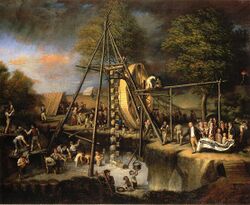
A Dutch tenant farmer found the first recorded remnant of Mammut, a tooth some 2.2 kg (5 lb) in weight, in the village of Claverack, New York, in 1705. The mystery animal became known as the "incognitum".[2] In 1739 French soldiers at present-day Big Bone Lick State Park, Kentucky, found the first bones to be collected and studied scientifically. They carried them to the Mississippi River, from where they were transported to the National Museum of Natural History in Paris.[3] Similar teeth were found in South Carolina, and some of the African slaves there supposedly recognized them as being similar to the teeth of African elephants. There soon followed discoveries of complete bones and tusks in Ohio. People started referring to the "incognitum" as a "mammoth", like the ones that were being dug out in Siberia[2] – in 1796 the French anatomist Georges Cuvier proposed the radical idea that mammoths were not simply elephant bones that had been somehow transported north, but a species which no longer existed.[4] Johann Friedrich Blumenbach assigned the scientific name Mammut to the American "incognitum" remains in 1799, under the assumption that they belonged to mammoths. Other anatomists noted that the teeth of mammoths and elephants differed from those of the "incognitum", which possessed rows of large conical cusps, indicating that they were dealing with a distinct species. In 1817 Cuvier named the "incognitum" Mastodon.[2]
Cuvier assigned the name mastodon (or mastodont) – meaning "breast tooth" (Ancient Greek: μαστός "breast" and ὀδούς, "tooth"),[5][6] – for the nipple-like projections on the crowns of the molars.
Taxonomy
Mastodon as a genus name is obsolete;[7] the valid name is Mammut, as that name preceded Cuvier's description, making Mastodon a junior synonym. The change was met with resistance, and authors sometimes applied "Mastodon" as an informal name; consequently it became the common term for members of the genus. "Mastodon" is also used informally to describe other non-elephant proboscideans, such as gomphotheres.
Species include:
- M. americanum, the American mastodon, is one of the best known and among the last species of Mammut. Its earliest occurrences date from the early-middle Pliocene (early Blancan stage). It was formerly regarded (see below) as having a continent-wide distribution, especially during the Pleistocene epoch,[8] known from fossil sites ranging from present-day Alaska, Ontario and New England in the north, to Florida, and as far south as Honduras.[9] Environmental DNA also suggests they ranged as far northeast as Greenland during the warmer conditions of the early Pleistocene.[10] It had tusks that sometimes exceeded 5 m (16 ft) in length; they curved upwards, but less dramatically than those of the woolly mammoth.[11] Its main habitat was cold spruce woodlands, and it is believed to have browsed in herds.[12] It became extinct at the end of the Pleistocene approximately 11,000 years ago.
- M. matthewi — found in the Snake Creek Formation of Nebraska, dating to the late Hemphillian (Late Miocene-Early Pliocene).[13] Some authors consider it practically indistinguishable from M. americanum.[8]
- M. pacificus — based on a 2019 analysis, Pleistocene specimens from California and southern Idaho have been transferred from M. americanum to this new species. It differs from the eastern population in having narrower molars, six as opposed to five sacral vertebrae, a thicker femur, and a consistent absence of mandibular tusks.[14]
- M. raki — Its remains were found in the Palomas Formation, near Truth or Consequences, New Mexico, dating from the early-middle Pliocene, between 4.5 and 3.6 Ma.[15] It coexisted with Equus simplicidens and Gigantocamelus and differs from M. americanum in having a relatively longer and narrower third molar,[8] similar to the description of the defunct genus Pliomastodon, which supports its arrangement as an early species of Mammut.[16] However, like M. matthewi, some authors do not consider it sufficiently distinct from M. americanum to warrant its own species.
- M. cosoensis — found in the Coso Formation of California, dating to the Late Pliocene, originally a species of Pliomastodon,[17] it was later assigned to Mammut.[18]
- M. furlongi, known from a partial mandible with three preserved molars (m1-m3) and a referred m3 from the Clarendonian of Oregon, originally placed in Pliomastodon.[14]
- M. nevadanus originally placed in Pliomastodon, based on a partial cranium with preserved molars and a right tusk from Thousand Creek beds of Humboldt County, Nevada, dating to the Late Miocene-Early Pliocene (Hemphillian) unlike M. americanum, the tusk curves downwards.[14]
- "M." borsoni known from the late Miocene to Early Pleistocene of Europe and China, one of the largest known proboscideans, its placement in the genus is equivocal, as its relationship with North American Mammut is unclear.[19]
Evolution

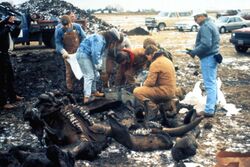
Mammut is a genus of the extinct proboscidean family Mammutidae, related to the family Elephantidae (mammoths and elephants), from which it originally diverged approximately twenty-seven million years ago.[20] The following cladogram shows the placement of the American mastodon among other proboscideans, based on hyoid characteristics:[21][22]
| ||||||||||||||||||||||
Mammutids originated in Africa during the Late Oligocene, with the oldest member of the family, Losodokodon known from deposits in Kenya approximately 24-27 million years old.[23] Mammutids expanded into Eurasia during the Early Miocene, approximately 18 million years ago, following the collision between the two landmasses.[19]
Mammutids, represented by Zygolophodon, first arrived in North America across the Bering Land Bridge during the late early Miocene,[19] approximately 16.5 million years ago.[24] Mammut is thought to have evolved from Zygolophodon, though the relationship between North American Mammut and some Eurasian species assigned to the genus, such as the Late Miocene-earliest Pleistocene species "Mammut" borsoni is uncertain.[19] Authors have proposed various hypotheses, including a second migration of mammutids into North America during the Late Miocene-Pliocene with the North American Mammut being descended from Eurasian Mammut species, or that the Eurasian and North American species of Mammut are not closely related and evolved in parallel. The second migration hypothesis has been criticised for lacking supporting evidence.[19]
Description


Compared to mammoths and extant elephants, mastodons had a longer and wider body but were not as tall due to their shorter legs. Their limbs were more heavily muscled and had considerably thicker limb bones, making mastodons much more robust in comparison to mammoths.[25][26][27] As in modern elephants, the females were smaller than the males. The average height for male M. americanum was about 2.9 m (9 ft 6 in) tall at the shoulder with an average body mass of 8 tonnes (7.9 long tons; 8.8 short tons); one male specimen represents this average almost perfectly at about 2.89 m (9 ft 6 in) at the shoulder with a body mass of about 7.8 tonnes (7.7 long tons; 8.6 short tons). The largest known male was about 3.25 m (10.7 ft) in shoulder height and about 11 tonnes (11 long tons; 12 short tons) in weight. These dimension make M. americanum about 80% heavier than modern elephants with equivalent shoulder heights.[28][26]

They had a low and long skull with long curved tusks,[29] with those of the males being more massive and more strongly curved.[28] Mastodons had cusp-shaped teeth, very different from mammoth and elephant teeth (which have a series of enamel plates), well-suited for chewing leaves and branches of trees and shrubs.[30] In contrast to its ancestor Zygolophodon, the lower jaw was shortened (brevirostrine), the lower tusks were vestigial or absent,[31] the upper tusks lacked an enamel band,[32] and the jaws lacked permanent premolar teeth.[33] The lower tusks were present in about a quarter of M. americanum individuals, but seem to have not been present at all in M. pacificus. M. pacificus is also suggested to be distinguished from M. americanum by its narrower molars, its consistent count of 6 sacral vertebrae, as opposed to the typical 5 in M. americanum (though the number in M. americanum varies from 4 to 6), its more robust femurs, and a smaller base male tusk diameter.[14] However, the distinction of M. pacificus from M. americanum has been questioned, as there is little genetic evidence for the presence of two species.[34]
Mastodons are typically depicted with a thick woolly mammoth-like coat of hair, but there is no preserved evidence for this, and consideration of the long tail (usually present in animals living in warm climates), size, body mass and environment implies the animal was not similarly hairy, and there is scant preserved evidence of body hair.[35][26]
Paleobiology
Social behavior
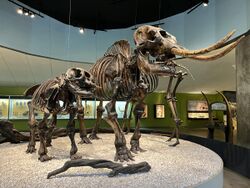
Based on the characteristics of mastodon bone sites and strontium and oxygen isotopes from tusks, it can be inferred that, as in modern proboscideans, the mastodon social group consisted of adult females and young, living in bonded groups called mixed herds. The males abandoned the mixed herds once reaching sexual maturity and lived either alone or in male bond groupings.[36][37] As in modern elephants,[38] there probably was no seasonal synchrony of mating activity, with both males and females seeking out each other for mating when sexually active.[37]
Diet
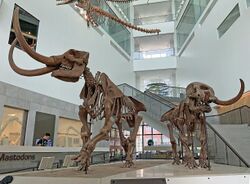
Mastodons have been characterized as predominantly browsing animals.[note 1] Of the New World proboscideans, they appear to have been the most consistent in browsing rather than grazing, consuming C3 as opposed to C4 plants, and in occupying closed forests versus more open habitats.[40] This dietary inflexibility may have prevented them from invading South America during the Great American Interchange, due to the need to cross areas of grassland to do so.[40] Most accounts of gut contents have identified coniferous twigs as the dominant element in their diet. Other accounts (e.g., the Burning Tree mastodon) have reported no coniferous content and suggest selective feeding on low, herbaceous vegetation, implying a mixed browsing and grazing diet,[41] with evidence provided by studies of isotopic bone chemistry indicating a seasonal preference for browsing.[42] Study of mastodon teeth microwear patterns indicates that mastodons could adjust their diet according to the ecosystem, with regionally specific feeding patterns corresponding to boreal forest versus cypress swamps, while a population at a given location was sometimes able to maintain its dietary niche through changes in climate and browse species availability.[43] Mastodons have been found to have been eating pumpkins along with species like woolly mammoths and other elephant species at the time. The pumpkin would have been too toxic for many animals but mastodons are able to avoid their toxicity due to their large body size.[44] Mastodons also distributed pumpkin seeds around the place aiding in pumpkin range expansion.[45]
Distribution and habitat
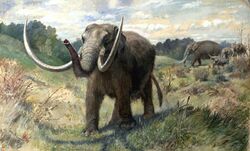
The range of most species of Mammut is unknown as their occurrences are restricted to few localities, the exception being the American mastodon (M. americanum), which is one of the most widely distributed Pleistocene proboscideans in North America. M. americanum fossil sites range in time from the Blancan to Rancholabrean faunal stages and in locations from as far north as Alaska, as far east as Florida, and as far south as the state of Puebla in central Mexico,[9] with an isolated record from Honduras, probably reflecting the results of the maximum expansion achieved by the American mastodon during the Late Pleistocene. A few isolated reports tell of mastodons being found along the east coast up to the New England region,[46][47] with high concentrations in the Mid-Atlantic region.[48][49] There is strong evidence indicating that the members of Mammut were forest dwelling proboscideans, predominating in woodlands and forests,[37] and browsed on trees and shrubs.[29] They apparently did not disperse southward to South America, it being speculated that this was because of a dietary specialization on a particular type of vegetation.[50]
The American mastodon was only present in the far north of North America during interglacial periods, with mitochondrial genome analysis suggesting that separate populations repeatedly colonised the region before becoming extirpated during glacial periods.[51] A 2022 study of ancient environmental DNA from the Kap Kobenhavn Formation of northern Greenland, dating the Early Pleistocene, 2 million years ago, identified preserved DNA fragments of mastodons, assigned to M. americanum. This suggests that mastodons ranged as far north as Greenland during optimal conditions. Around this time, northern Greenland was 11–19 °C warmer than the Holocene, with a boreal forest hosting a species assemblage with no modern analogue. These are among the oldest DNA fragments ever sequenced.[10][52]
Extinction
Fossil evidence indicates that mastodons probably disappeared from North America about 10,500 years ago[1] as part of the Quaternary extinction event of most of the Pleistocene megafauna that is widely believed to have been a result of human hunting pressure.[53][54] The latest Paleo-Indians entered the Americas and expanded to relatively large numbers 13,000 years ago,[55] and their hunting may have caused a gradual attrition of the mastodon population.[56][57] Analysis of tusks of mastodons from the American Great Lakes region over a span of several thousand years prior to their extinction in the area shows a trend of declining age at maturation; this is contrary to what one would expect if they were experiencing stresses from an unfavorable environment, but is consistent with a reduction in intraspecific competition that would result from a population being reduced by human hunting.[57]
On the other hand, environmental DNA sequencing indicates that disappearance of megafaunal DNA in North America correlates in time with major changes in plant DNA, suggesting a key role of climate change.[58] Modeling based on the whole of the proboscid fossil record also suggests climate was the more important factor, though with human hunting imposing a "double jeopardy" on mastodons and their kin.[59]
See also
- Coats–Hines site
- List of museums and colleges with mastodon fossils on display
- Manis Mastodon site
- Snowmastodon site
- Cerutti Mastodon site
- Big Bone Lick State Park
Notes
- ↑ Browsing is a type of herbivory in which a herbivore (or, more narrowly defined, a folivore) feeds on leaves, soft shoots, or fruits of high growing, generally woody, plants such as shrubs.[39] This is contrasted with grazing, usually associated with animals feeding on grass or other low vegetation.
References
- ↑ 1.0 1.1 Fiedal, Stuart (2009). "Sudden Deaths: The Chronology of Terminal Pleistocene Megafaunal Extinction". in Haynes, Gary. American Megafaunal Extinctions at the End of the Pleistocene. Vertebrate Paleobiology and Paleoanthropology. Springer. pp. 21–37. doi:10.1007/978-1-4020-8793-6_2. ISBN 978-1-4020-8792-9. https://link.springer.com/content/pdf/10.1007%2F978-1-4020-8793-6.pdf.
- ↑ 2.0 2.1 2.2 Conniff, Richard (April 2010). "Mammoths and Mastodons: All American Monsters". Smithsonian Magazine. http://www.smithsonianmag.com/science-nature/Mammoths-and-Mastodons-All-American-Monsters.html. Retrieved December 5, 2019. "In the summer of 1705, in the Hudson River Valley village of Claverack, New York, a tooth the size of a man's fist surfaced on a steep bluff, rolled downhill and landed at the feet of a Dutch tenant farmer, who promptly traded it to a local politician for a glass of rum. [...] this 'monstrous creature,' [...] would soon become celebrated as the 'incognitum,' the unknown species.".
- ↑ Kolbert, Elizabeth (2014). The sixth extinction : an unnatural history (First ed.). New York: Henry Holt and Co. pp. 25–26. ISBN 978-0805092998. https://archive.org/details/isbn_9780805092998.
- ↑ Cuvier, G. (1796). "Mémoire sur les épèces d'elephans tant vivantes que fossils, lu à la séance publique de l'Institut National le 15 germinal, an IV" (in fr). Magasin Encyclopédique, 2e Anée: 440–445.
- ↑ mastodon Online Etymology Dictionary Retrieved November 10, 2012
- ↑ mastodon Merriam-Webster Retrieved June 30, 2012
- ↑ Agusti, Jordi; Mauricio Anton (2002). Mammoths, Sabretooths, and Hominids. New York: Columbia University Press. pp. 106. ISBN 0-231-11640-3.
- ↑ 8.0 8.1 8.2 Ruez, D. R. (2007). "Chapter 4: Revision of the blancan mammals from Hagerman fossil beds, National monument, Idaho". Effects of Climate Change on Mammalian Fauna Composition and Structure During the Advent of North American Continental Glaciation in the Pliocene. pp. 249–252. ISBN 978-0549266594. https://books.google.com/books?id=Y7CniYHrUoQC.[yes|permanent dead link|dead link}}]
- ↑ 9.0 9.1 Polaco, O. J.; Arroyo-Cabrales, J.; Corona-M., E.; López-Oliva, J. G. (2001). "The American Mastodon Mammut americanum in Mexico". in Cavarretta, G.; Gioia, P.; Mussi, M. et al.. The World of Elephants – Proceedings of the 1st International Congress, Rome October 16–20, 2001. Rome: Consiglio Nazionale delle Ricerche. pp. 237–242. ISBN 88-8080-025-6. http://www.sovraintendenzaroma.it/content/download/4787/62368/.../237_242.pdf. Retrieved July 25, 2008.
- ↑ 10.0 10.1 Kjær, Kurt H.; Winther Pedersen, Mikkel; De Sanctis, Bianca; De Cahsan, Binia; Korneliussen, Thorfinn S.; Michelsen, Christian S.; Sand, Karina K.; Jelavić, Stanislav et al. (December 2022). "A 2-million-year-old ecosystem in Greenland uncovered by environmental DNA" (in en). Nature 612 (7939): 283–291. doi:10.1038/s41586-022-05453-y. ISSN 1476-4687. PMID 36477129. Bibcode: 2022Natur.612..283K.
- ↑ Kurtin, Bjvrn; Björn Kurtén Elaine Anderson (1980). Pleistocene Mammals of North America (illustrated ed.). Columbia University Press. p. 345. ISBN 0231037333. https://books.google.com/books?id=f8pviaxPIKEC.
- ↑ Palmer, D., ed (1999). The Marshall Illustrated Encyclopedia of Dinosaurs and Prehistoric Animals. London: Marshall Editions. p. 243. ISBN 1-84028-152-9.
- ↑ Osborn, H. F. (1936). Percy, M. R.. ed. Proboscidea: A monograph of the discovery, evolution, migration and extinction of the mastodonts and elephants of the world. 1. New York: J. Pierpont Morgan Fund. doi:10.5962/bhl.title.12097.
- ↑ 14.0 14.1 14.2 14.3 Dooley, A. C.; Scott, E.; Green, J.; Springer, K. B.; Dooley, B. S.; Smith, G. J. (2019). "Mammut pacificus sp. nov., a newly recognized species of mastodon from the Pleistocene of western North America". PeerJ 7: e 6614. doi:10.7717/peerj.6614. PMID 30944777.
- ↑ Morgan, Gary S.; Spencer G. Lucas (2001). "Summary of Blancan and Irvingtonian (Pliocene and early Pleistocene) Mammalian Biochronology of New Mexico". New Mexico Bureau of Mines and Mineral Resources Open-File Report 454B: 29–32. http://geoinfo.nmt.edu/publications/openfile/downloads/OFR400-499/451-475/454/papers/ofr454B_pdf/B-Lucas-Morgan_PlioceneBiostratigraphy_final.pdf. Retrieved 2013-01-25.
- ↑ Lucas, Spencer G.; Morgan, Gary S. (February 1999). "The oldest Mammut (Mammalia: Proboscidea) from New Mexico". New Mexico Geology 21: 10–12. doi:10.58799/NMG-v21n1.10.
- ↑ Schultz, J. R. (1937). "A Late Cenozoic Vertebrate Fauna from the Coso Mountains, Inyo County, California". Carnegie Institution of Washington Publication 483 (3): 77–109.
- ↑ Jeheskel Shoshani; Pascal Tassy (1996). "Summary, conclusions, and a glimpse into the future". The Proboscidea: Evolution and Palaeoecology of Elephants and Their Relatives (illustrated ed.). Oxford University Press. pp. 335–348. ISBN 0198546521. https://archive.org/details/proboscideaevolu00shos.
- ↑ 19.0 19.1 19.2 19.3 19.4 Koenigswald, Wighart; Březina, Jakub; Werneburg, Ralf; Göhlich, Ursula (2022). "A partial skeleton of "Mammut" borsoni (Proboscidea, Mammalia) from the Pliocene of Kaltensundheim (Germany)". Palaeontologia Electronica 25 (1): 1–45. doi:10.26879/1188. https://palaeo-electronica.org/content/2022/3573-mammut-kaltensundheim.
- ↑ Shoshani, J.; Walter, R. C.; Abraha, M.; Berhe, S.; Tassy, P.; Sanders, W. J.; Marchant, G. H.; Libsekal, Y. et al. (July 24, 2007). "A proboscidean from the late Oligocene of Eritrea, a "missing link" between early Elephantiformes and Elephantimorpha, and biogeographic implications". Proceedings of the National Academy of Sciences 103 (46): 17296–17301. doi:10.1073/pnas.0603689103. ISSN 0027-8424. PMID 17085582. Bibcode: 2006PNAS..10317296S.
- ↑ Shoshani, J.; Tassy, P. (2005). "Advances in proboscidean taxonomy & classification, anatomy & physiology, and ecology & behavior". Quaternary International 126–128: 5–20. doi:10.1016/j.quaint.2004.04.011. Bibcode: 2005QuInt.126....5S.
- ↑ Shoshani, J.; Ferretti, M. P.; Lister, A. M.; Agenbroad, L. D.; Saegusa, H.; Mol, D.; Takahashi, K. (2007). "Relationships within the Elephantinae using hyoid characters". Quaternary International 169-170: 174–185. doi:10.1016/j.quaint.2007.02.003. Bibcode: 2007QuInt.169..174S.
- ↑ Rasmussen, D. Tab; Gutierrez, Mercedes (2009). "A mammalian fauna from the late Oligocene of northern Kenya". Palaeontographica Abteilung A 288 (1): 7–52. doi:10.1127/pala/288/2009/1.
- ↑ Koenigswald, Widga & Göhlich (2021): New mammutids (Proboscidea) from the Clarendonian and Hemphillian of Oregon – a survey of Mio-Pliocene mammutids from North America
- ↑ Lange, I.M. (2002). Ice Age Mammals of North America: A Guide to the Big, the Hairy, and the Bizarre (illustrated ed.). Mountain Press Publishing. pp. 166–168. ISBN 0878424032. https://archive.org/details/isbn_9780878424030.
- ↑ 26.0 26.1 26.2 Larramendi, A. (2015). "Shoulder Height, Body Mass, and Shape of Proboscideans". Acta Palaeontologica Polonica. doi:10.4202/app.00136.2014. https://www.app.pan.pl/archive/published/app61/app001362014.pdf.
- ↑ "Xena the mammoth's femur". 2 September 2016. https://www.westernsciencecenter.org/blog/2016/09/02/fossil-friday-xena-the-mammoths-femur#.
- ↑ 28.0 28.1 Woodman, N. (2008). "The Overmyer Mastodon (Mammut americanum) from Fulton County, Indiana". The American Midland Naturalist 159 (1): 125–146. doi:10.1674/0003-0031(2008)159[125:TOMMAF2.0.CO;2]. http://digitalcommons.unl.edu/cgi/viewcontent.cgi?article=1590&context=usgsstaffpub.
- ↑ 29.0 29.1 Lucas, Spencer G.; Guillermo E. Alvarado (2010). "Fossil Proboscidea from the Upper Cenozoic of Central America: Taxonomy, Evolutionary and Pelobiogeographic Significance". Revista Geológica de América Central. 42: 9–42. ISSN 0256-7024.
- ↑ Sullivan, Robert M. (2010). "Rising from the muck: The Marshalls Creek mastodon". Pennsylvania Heritage.
- ↑ Mothé, Dimila; Avilla, Leonardo S.; Zhao, Desi; Xie, Guangpu; Sun, Boyang; Mothé, Dimila; Avilla, Leonardo S.; Zhao, Desi et al. (2016). "A new Mammutidae (Proboscidea, Mammalia) from the Late Miocene of Gansu Province, China". Anais da Academia Brasileira de Ciências 88 (1): 65–74. doi:10.1590/0001-3765201520150261. ISSN 0001-3765. PMID 26839998.
- ↑ Yaghoubi, Sadaf; Ashouri, Ali Reza; Ataabadi, Majid Mirzaie; Ghaderi, Abbas (2023-07-05). First true mastodon from the Late Miocene of Western Asia (Report). In Review. doi:10.21203/rs.3.rs-3046011/v1. https://www.researchsquare.com/article/rs-3046011/v1.
- ↑ Sanders, William J. (2018-02-17). "Horizontal tooth displacement and premolar occurrence in elephants and other elephantiform proboscideans" (in en). Historical Biology 30 (1–2): 137–156. doi:10.1080/08912963.2017.1297436. ISSN 0891-2963. Bibcode: 2018HBio...30..137S. https://www.tandfonline.com/doi/full/10.1080/08912963.2017.1297436.
- ↑ Karpinski, Emil; Widga, Chris; Boehm, Andrew R.; Peecook, Brandon R.; Kuch, Melanie; Murchie, Tyler J.; Poinar, Hendrik N. (June 2023). "Mastodon mitochondrial genomes from American falls, Idaho" (in en). Quaternary International 668: 1–6. doi:10.1016/j.quaint.2023.06.006. Bibcode: 2023QuInt.668....1K. https://linkinghub.elsevier.com/retrieve/pii/S1040618223002136.
- ↑ Witton, M. (26 August 2020). "The "palaeontological folklore" of mastodon hair". https://markwitton-com.blogspot.com/2020/08/the-palaeontological-folklore-of.html.
- ↑ Miller, Joshua H.; Fisher, Daniel C.; Crowley, Brooke E.; Secord, Ross; Konomi, Bledar A. (2022-06-21). "Male mastodon landscape use changed with maturation (late Pleistocene, North America)" (in en). Proceedings of the National Academy of Sciences 119 (25): e2118329119. doi:10.1073/pnas.2118329119. ISSN 0027-8424. PMID 35696566. Bibcode: 2022PNAS..11918329M.
- ↑ 37.0 37.1 37.2 Haynes, G.; Klimowicz, J. (2003). "Mammoth (Mammuthus spp.) and American mastodont (Mammut americanum) bonesites: what do the differences mean?". Advances in Mammoth Research 9: 185–204. http://natuurtijdschriften.nl/record/538680.
- ↑ Sukumar, R. (September 11, 2003). The Living Elephants: Evolutionary Ecology, Behaviour, and Conservation. Oxford University Press, USA. p. 262. ISBN 978-0-19-510778-4. OCLC 935260783. https://archive.org/details/livingelephantse00suku_0.
- ↑ Chapman, J.L. and Reiss, M.J., Ecology: Principles and Applications. Cambridge, U.K.: Cambridge University Press, 1999. p. 304. (via Google books, February 25, 2008)
- ↑ 40.0 40.1 Pérez-Crespo, V.A.; Prado, J.L.; Alberdi, M.T.; Arroyo-Cabrales, J.; Johnson, E. (2016). "Diet and Habitat for Six American Pleistocene Proboscidean Species Using Carbon and Oxygen Stable Isotopes". Ameghiniana 53 (1): 39–51. doi:10.5710/AMGH.02.06.2015.2842.
- ↑ Lepper, B. T.; Frolking, T. A.; Fisher, D. C.; Goldstein, G.; Sanger, J. E.; Wymer, D. A.; Ogden, J.G.; Hooge, P. E. (1991). "Intestinal Contents of a late Pleistocene Mastodont from Midcontinental North America". Quaternary Research 36 (1): 120–125. doi:10.1016/0033-5894(91)90020-6. Bibcode: 1991QuRes..36..120L. https://deepblue.lib.umich.edu/bitstream/2027.42/29243/1/0000299.pdf.
- ↑ Fisher, D. C. (1996). "Extinction of Proboscideans in North America". in Shoshani, J.. The Proboscidea: Evolution and Palaeoecology of Elephants and Their Relatives. Oxford, UK: Oxford University Press. pp. 296–315. ISBN 978-0-19-854652-8. https://archive.org/details/proboscideaevolu00shos.
- ↑ Green, J. L.; DeSantis, L. R. G.; Smith, G. J. (2017). "Regional variation in the browsing diet of Pleistocene Mammut americanum (Mammalia, Proboscidea) as recorded by dental microwear textures". Palaeogeography, Palaeoclimatology, Palaeoecology 487: 59–70. doi:10.1016/j.palaeo.2017.08.019. Bibcode: 2017PPP...487...59G.
- ↑ "Smithsonian Insider – Study reveals ancient link between mammoth dung and pumpkin pie | Smithsonian Insider" (in en-US). 2015-11-23. https://insider.si.edu/2015/11/dull-mastadon-taste-buds-once-helped-pumpkins-wild-ancestor-thrive/.
- ↑ "Loss of mastodons aided domestication of pumpkins, squash | Penn State University" (in en). https://www.psu.edu/news/research/story/loss-mastodons-aided-domestication-pumpkins-squash/.
- ↑ "Northborough's Mastodon". Northborough MA Letterboxing. 2007-09-15. http://northboroletterboxing.blogspot.com/2007/09/mastodon.html.
- ↑ "Prehistoric Massachusetts". The Paleontology Portal. http://www.paleoportal.org/index.php?globalnav=time_space§ionnav=state&name=Massachusetts.
- ↑ "Cohoes Mastodon". Cohoes.com. https://www.ci.cohoes.ny.us/315/Cohoes-Mastodon.
- ↑ "Prehistoric New York: Mastodons". Discovery Channel. http://www.discovery.com/tv-shows/other-shows/videos/prehistoric-new-york-mastodons.htm.
- ↑ Prado, J. L.; Alberdi, M. T.; Azanza, B.; Sánchez, B.; Frassinetti, D. (2005). "The Pleistocene Gomphotheriidae (Proboscidea) from South America". Quaternary International 126–128: 21–30. doi:10.1016/j.quaint.2004.04.012. Bibcode: 2005QuInt.126...21P.
- ↑ Karpinski, E.; Hackenberger, D.; Zazula, G.; Widga, C.; Duggan, A.T.; Golding, G.B.; Kuch, M.; Klunk, J. et al. (2020). "American mastodon mitochondrial genomes suggest multiple dispersal events in response to Pleistocene climate oscillations". Nature Communications 11 (1): 4048. doi:10.1038/s41467-020-17893-z. PMID 32873779. Bibcode: 2020NatCo..11.4048K.
- ↑ Pappas, Stephanie. "World's Oldest DNA Discovered, Revealing Ancient Arctic Forest Full of Mastodons" (in en). https://www.scientificamerican.com/article/worlds-oldest-dna-discovered-revealing-ancient-arctic-forest-full-of-mastodons/.
- ↑ "Chapter 6. Deadly Syncopation". Twilight of the Mammoths: Ice Age Extinctions and the Rewilding of America. University of California Press. 2005. pp. 118–128. ISBN 0-520-23141-4. OCLC 58055404. https://books.google.com/books?id=gfpla1OY268C&pg=PA118. Retrieved February 1, 2016.
- ↑ Burney, D. A.; Flannery, T. F. (July 2005). "Fifty millennia of catastrophic extinctions after human contact". Trends in Ecology & Evolution (Elsevier) 20 (7): 395–401. doi:10.1016/j.tree.2005.04.022. PMID 16701402. http://www.anthropology.hawaii.edu/Fieldschools/Kauai/Publications/Publication%204.pdf. Retrieved June 12, 2009.
- ↑ Beck, Roger B.; Black, Linda; Krieger, Larry S.; Naylor, Phillip C.; Shabaka, Dahia Ibo (1999). World History: Patterns of Interaction. Evanston, Illinois: McDougal Littell. ISBN 0-395-87274-X. https://archive.org/details/mcdougallittellw00beck.
- ↑ Ward, Peter (1997). The Call of Distant Mammoths. Springer. pp. 241. ISBN 978-0-387-98572-5. https://books.google.com/books?id=E-JRXiFbcwkC.
- ↑ 57.0 57.1 Fisher, Daniel C. (2009). "Paleobiology and Extinction of Proboscideans in the Great Lakes Region of North America". in Haynes, Gary. American Megafaunal Extinctions at the End of the Pleistocene. Vertebrate Paleobiology and Paleoanthropology. Springer. pp. 55–75. doi:10.1007/978-1-4020-8793-6_4. ISBN 978-1-4020-8792-9.
- ↑ Willerslev, Eske; Davison, John; Moora, Mari; Zobel, Martin; Coissac, Eric; Edwards, Mary E.; Lorenzen, Eline D.; Vestergård, Mette et al. (February 2014). "Fifty thousand years of Arctic vegetation and megafaunal diet". Nature 506 (7486): 47–51. doi:10.1038/nature12921. PMID 24499916. Bibcode: 2014Natur.506...47W. https://eprints.soton.ac.uk/377215/1/131114_ms%252BSI.pdf.
- ↑ "The rise and fall of proboscidean ecological diversity". Nature Ecology and Evolution 5 (2021): 1266–1272. July 2021. doi:10.1038/s41559-021-01498-w. PMID 34211141. Bibcode: 2021NatEE...5.1266C. ""...climate change is the likely culprit in the demise of prehistoric mammoths, mastodons and early elephants rather than overhunting by early humans at the end of the last Ice Age.... Overhunting by humans may have served as a final double jeopardy in the late Pleistocene after climate-triggered extinction trends that began long before hominins evolved suitable hunting capabilities."".
External links
| Wikisource has the text of the 1911 Encyclopædia Britannica article Mastodon. |
- The Rochester Museum of Science – Expedition Earth Glaciers & Giants
- Illinois State Museum – Mastodon
- Calvin College Mastodon Page
- American Museum of Natural History – Warren Mastodon
- BBC Science and Nature:Animals – American mastodon Mammut americanum
- BBC News – Greek mastodon find 'spectacular'
- Missouri State Parks and Historic Sites – Mastodon State Historic Site
- Saint Louis Front Page – Mastodon State Historic Site
- Story of the Randolph Mastodon (Earlham College)
- The Florida Museum of Natural History Virtual Exhibit – The Aucilla River Prehistory Project:When The First Floridians Met The Last Mastodons
- Western Center for Archaeology & Paleontology, home of the largest mastodon ever found in the Western United States
- Smithsonian Magazine Features Mammoths and Mastodons
- 360 View of a Mastodon Skull from Indiana State Museum
- 3-D Viewers of male and female mastodon skeletons at the University of Michigan Mammutidae digital fossil repository
- Scientific American, "The Chicago Mastodon", 18 September 1880, p. 175
Wikidata ☰ Q192272 entry
 |

